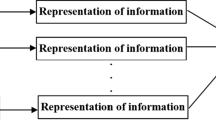Abstract
In this paper, an adaptive neural network approach to classification which combines modified probabilistic neural network and D-S evidence theory (PNN-DS) is proposed. It attempts to deal with the drawbacks of information uncertainty and imprecision using single classification algorithm. This PNN-DS approach firstly adopts a modified PNN to obtain posteriori probabilities and make a primary classification decision in feature-level fusion. Then posteriori probabilities are transformed to masses noting the evidence of the D-S evidential theory. Finally advanced D-S evidential theory is utilized to gain more accurate classification results in the last decision-level fusion. In order to implement PNN-DS, covariance matrices are firstly employed in the modified PNN module to replace the singular smoothing factor in the PNN’s kernel function, and linear function is utilized in the pattern of summation layer. Secondly, the whole scheme of the proposed approach is explained in depth. Thirdly, three classification experiments are carried out on the proposed approach and a large amount of comparable analyses are done to demonstrate the effectiveness and robustness of the proposed approach. Experiments reveal that the PNN-DS outperforms BPNN-DS, which provides encouraging results in terms of classification accuracy and the speed of learning convergence.













Similar content being viewed by others
References
Basir O, Karray F, Zhu H (2005) Connectionist-based Dempster–Shafer evidential reasoning for data fusion. IEEE Trans Neural Netw 16:1513–1516
Hégarat-Mascle SL, Bloch I, Vidal-Madjar D (1997) Application of Dempster–Shafer evidence theory to unsupervised classification in multisource remote sensing. IEEE Trans Geosci Remote Sens 35:1018–1031
Hégarat-Mascle SL, Bloch I, Vidal-Madjar D (1998) Introduction of neighborhood information in evidence theory and application to data fusion of radar and optical images with partial cloud cover. Pattern Recognit 31:1811–1823
Bloch I (1996) Some aspects of Dempster-Shafer evidence theory for classification of multi-modality medical images taking partial volume effect into account. Pattern Recognit Lett 17:905–919
Rombaut M, Zhu YM (2002) Study of Dempster–Shafer for image segmentation applications. Image Vis Comput 20:15–23
Huang J, Cheng Y, Pi Y, Pan Q (2005) Airplane image recognition based on BP neural network and DS evidence reasoning. Comput Simul China 22:184–186
Zhang C (2006) Methods of multi-sensor data fusion and their application in the spatial targets recognition. Doctoral Dissertation, 249(122):1–11
Tang S, Gao S, Xing H (2007) Research of information fusion model combining DS evidence theory and neural network. Chin J Sens Actuators 20:1815–1818
Poirazi P, Neocleous C, Pattichis CS, Schizas CN (2004) Classification capacity of a modular neural network implementing neurally inspired architecture and training rules. IEEE Trans Neural Netw 15:597–612
Specht DF (1990) Probabilistic neural networks. Neural Netw 3:109–118
Song T, Jamshidi MM, Lee RR, Huang M (2007) A modified probabilistic neural network for partial volume segmentation in brain MR image. IEEE Trans Neural Netw 18:1424–1432
Zhang C, Cui P, Zhang Y (2006). An algorithm of data fusion combined neural networks with DS evidential theory. 1st International Aerospace and Astronautics ISSCAA 2006, Harbin, China (EI), pp 1141–1144
Zhang C, Cui P, Zhang Y (2006). An algorithm of characteristic data fusion based on neural network group. Proceedings of the Fifth International Conference on Machine Learning and Cybernetics, pp 2917–2919
Zhu H, Basir O (2006) A novel fuzzy evidential reasoning paradigm for data fusion with applications in image processing. Soft Comput 10:1169–1180
Acknowledgments
This work was jointly supported by the National Science Fund for Distinguished Young Scholars (Grant No: 60625304), the National Natural Science Foundation of China (Grants No: 60621062, 60504003, 60474025, 90405017), the National Key Project for Basic Research of China (Grant No: G2007CB311003, G2002cb312205) and the Specialized Research Fund for the Doctoral Program of Higher Education (Grant No: 20050003049).
Author information
Authors and Affiliations
Corresponding author
Rights and permissions
About this article
Cite this article
Chen, N., Sun, F., Ding, L. et al. An adaptive PNN-DS approach to classification using multi-sensor information fusion. Neural Comput & Applic 18, 455–467 (2009). https://doi.org/10.1007/s00521-008-0220-4
Received:
Accepted:
Published:
Issue Date:
DOI: https://doi.org/10.1007/s00521-008-0220-4




